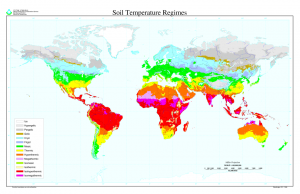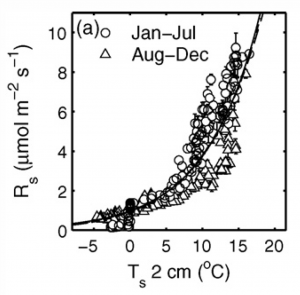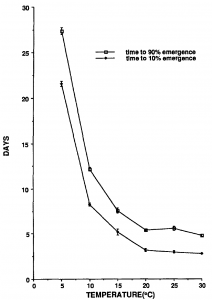13. Soil Temperature
In the prior chapter, we focused on the partitioning of energy at the soil surface between net radiation, latent heat flux, sensible heat flux, and soil heat flux. One of the key variables that controls or is controlled by that energy partitioning is soil temperature. The aim of this chapter is to explain how soil temperatures vary in space and time and how soil temperatures impact a wide variety of biological, chemical, and physical processes in the soil. The global distribution of soil temperature regimes reflects the wide range of soil thermal environments, from soils with a megathermic temperature regime having mean annual temperatures at the 50-cm depth >28°C, to soils in the hypergelic temperature regime with mean annual temperatures <-10°C (Fig. 13‑1).

Soil temperature strongly affects the global carbon cycle by influencing the soil respiration rate, which includes respiration of both soil microbes and plant roots. The soil respiration rate under boreal forest in Canada shows a strong logarithmic relationship with soil temperature (Fig. 13‑2) [1], and similar relationships have been observed for many other locations and ecosystems around the world. If rising global temperatures cause increased soil respiration resulting in a net transfer of soil organic carbon to the atmosphere, then a positive feedback to climate change would occur [2].

Multiple plant growth processes can also be strongly influenced by soil temperature. For example, soil temperature is one of the primary factors controlling the germination and early growth of many crops. The time required for winter wheat seedlings to emerge decreases from >25 days at a soil temperature of 5°C to ~5 days at 20°C (Fig. 13‑3) [3]. For corn, warmer early season soil temperatures hasten plant development, increase leaf size in the upper half of the canopy, and linearly increase end-of-season grain yields [4]. In recent decades, long-term increases in soil temperature have been documented [5], and these increases may have significance for crop production. Perhaps in response to rising soil temperatures, there has been a trend toward earlier planting dates in the major corn-producing region of the US, the Corn Belt, and these earlier planting dates have contributed significantly to yield increases, especially in the more northern parts of the Corn Belt [6].


